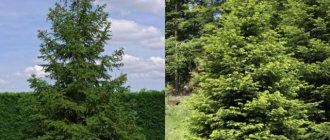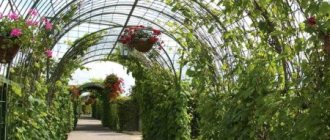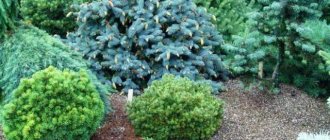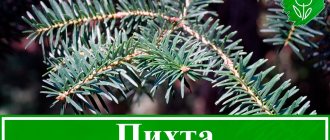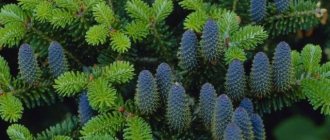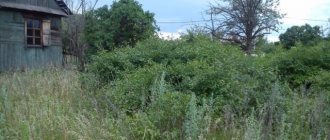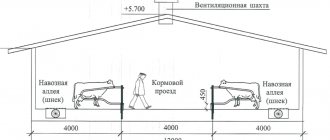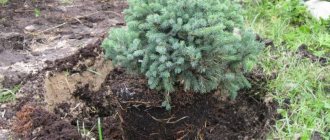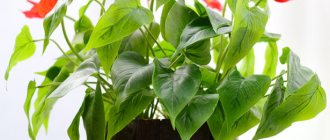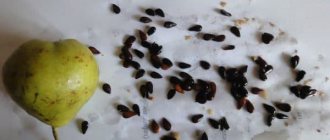Growing fir in a pot will give you pleasure and delight you with the results
Growing fir in a pot is very fashionable today.
An evergreen coniferous tree with a pleasant aroma can be kept in an apartment or country house and used instead of a Christmas tree. At home it does not grow as quickly as outside. Fir in a pot grows by about 5 cm every year. It looks great both in a living space and in an office. For home keeping, it is necessary to choose dwarf specimens. It is better if these are frost-resistant varieties, then the tree can be kept on the balcony. But it should not be completely open, because the earthen ball and roots freeze faster in the container than in open ground. We must not forget about this.
Is it possible to grow fir in an apartment?
There are no particular difficulties when growing fir at home, since these trees take root well in almost any natural environment.
There is no need to worry that the fir in the house will be too hot. Having a southern or even subtropical origin (fir is native to the Caucasus and Central America), plants generally have good tolerance to a wide range of temperatures (from - 30 ° C to + 35 ° C). They are able to go without water for quite a long time, and they can tolerate drought much easier than excessive waterlogging.
Propagation by seeds
An evergreen tree is easy to grow from seeds.
This process is not very difficult. For this grain:
- Collected from fully ripe cones. But before planting fir seeds, they must be kept in the refrigerator for about a month (stratification is carried out).
- Before planting, the seeds are soaked for 20-24 hours in water at room temperature.
- They are sown in autumn or spring, but it is preferable to plant in April. There is no need to deeply bury the grains.
- The soil with the seed is kept moist in a greenhouse (under a film, a jar).
- When the shoots with the first leaves appear, the film is removed.
- Sprouts 8-10 cm high are each transplanted into a separate container, diving.
Even if you plan to plant specimens on the site in the future, it is better to keep them in pots for the first 3 years.
Propagation by cuttings
Before you grow fir from a branch, you should know that during vegetative propagation, cuttings take root for a very long time - from several months to a year.
The whole process consists of several stages:
- Woody adult shoots are selected first.
- Cut cuttings 10-12 cm long.
- The lower part is cleared of needles and dipped in a stimulant solution.
- The seedlings are placed in a well-moistened mixture of peat and sand and covered with a film, which is removed only after rooting.
While the fir in the pot is very small, it is grown indoors. But since the tree is a real long-liver, capable of growing for hundreds of years, you will have to buy a tub and a decorative stand with wheels for it over time. This makes it easier to move an adult plant.
Reproduction
Korean fir reproduces safely at home. To do this, use one of several methods.
Propagation of Korean fir by seeds
Growing fir seedlings from seeds is one of the most difficult methods. First of all, planting material must be obtained, and often the seeds simply scatter from the ripe cones. It is necessary to take the still unopened cone, dry it, remove the seeds and send them to a cold place for stratification. The material is sown in the first ten days of April and the bed is covered with film, creating a greenhouse. When the first shoots appear, the protection must be removed. The bed is regularly watered, weeded and loosened. Transplantation to a permanent place is carried out after a year.
Propagation of Korean fir by cuttings
Korean fir cuttings are a fairly popular method among gardeners, although they take a long time to form roots. The material chosen is annual shoots no longer than 8 cm. They must be plucked so that a fragment of the mother wood (heel) remains.
Before planting, the cuttings are treated with foundationazole to eliminate possible infections. It is also advisable to sterilize the soil mixture for half an hour in the oven. The cuttings planted in the container are covered with film or glass. During the wintering period, the bed is moved to a basement with a lower temperature, and in the spring it is left in the fresh air. Rooting will occur no earlier than in the second year.
Reproduction of Korean fir by layering
This method is considered one of the simplest. The bottom line is that you need to lightly dig in one of the lower branches of the tree and fix it in a previously prepared trench. Rooting will occur within two years. An interesting fact is that in this way the fir can reproduce without human intervention - it is enough for the branch to come into contact with the ground. The disadvantage of this method is the risk of the newly created crop losing its cone-shaped crown.
Transplanting a purchased seedling
If a fir seedling was purchased in the winter months, then there is no need to rush to replant it. It is necessary to hold it a little in the same conditions in which it grew earlier. If the store or nursery was cool, then the seedling should be placed on the balcony for several days. Then move it in its original container to the place where it is planned to be kept permanently. And only then should the transplantation begin.
Many people are interested in how long fir grows. In a pot it will grow by about five centimeters every year. So sooner or later it will have to be transplanted into open ground. And there she can live for more than a hundred years.
Fir does not like drafts; it is better to choose a cool, dark place for it, but it will also grow in a brightly lit window. Before replanting the plant, it must be watered well so that the substrate becomes moist and well saturated with water.
Choosing an indoor fir seedling
How well the ephedra will take root in indoor conditions depends on the quality of the planting material. It is best to purchase seedlings from specialized nurseries with a good reputation. When buying an ephedra from your own hands, there is always a risk of being deceived and becoming the owner of an ordinary tall plant for open ground. At a young age, many varieties are similar to each other, and even professionals cannot always distinguish them.
It is better to buy fir seedlings in a container; such plants take root better in new pots
When purchasing an ephedra, you need to pay attention to the following points:
- seedling age, plants 4-5 years old are best;
- the condition of the earthen ball or soil in the pot, the soil should be moist, but without mold;
- elasticity, branches should bend easily when tilted;
- integrity of shoots - the seedling should not have dry or broken branches.
Important! It is better not to buy plants with bare roots either for the home or for the garden; such conifers, in principle, take root much worse and often die.
Choosing a pot
Drainage in a pot with fir is required. When the earthen clod becomes waterlogged and water stagnates, its roots rot very quickly. To grow fir in a pot, it should be taken into account that the new container should be 5-10 liters larger than the original one. Together with the earthen lump, the seedling is simply transferred to a new container and the required amount of soil is added.
A large pot has a number of advantages:
- the wood in it is more stable;
- the soil remains moist for quite a long time;
- There is no need to replant the plant frequently; it is enough to change the pot every 3 years.
The most favorable period for replanting fir is September or October.
Related article: Syzygium description and features
Features of planting a tree at home
A tree in a container will look very impressive, but its propagation will require adherence to some rules. And to make it easier to care for the tree, it is advisable to use a stand for a container on wheels; with its help it will be easier to move an adult tree around the room.
Illumination, humidity and temperature conditions
If the plant was purchased in winter, then before planting it in a permanent container, it must be given time to get used to the new conditions. At first, the conditions should not differ from store conditions, that is, the temperature should be lower than in the room. As soon as the seedling gets used to the situation, it should be placed in the place where it will stand in the future. A good tray and drainage should be prepared in advance, because the plant loves moist soil, but cannot tolerate the accumulation of water, since in these conditions its roots will rot. Any air is suitable for good plant growth. There is absolutely no need to organize any measures that will relate to moistening the tree’s habitat.
How to choose a container for planting
The purchased tree can be immediately planted in a large container with a capacity of 10 liters with optimal soil, so as not to destroy the lump of earth near the rhizome. It is preferable to grow a plant in large containers, since they are more stable and can hold more soil, while the soil in them will remain moist for more time. But it is necessary to pick dwarf fir into large containers every 3 years. The most suitable period for picking is September-October. In order for the plant to take root in a new container, there is no need to clear the soil from the roots, and the soil after replanting must be fed with preparations.
Preparing soil for planting
The main thing you need to worry about is choosing the right soil. The soil should be nutritious and neutral, it is possible to use slightly alkaline soil. In a natural environment, plant cultivation is carried out using seeds, so it is advisable to select light soils, loams, a ready-made composition for coniferous trees or a special composition consisting of clay, peat, sand and leaf soil as a basis. And in order to maintain good nutrition during planting, complex fertilizing should be applied. In this case, it is necessary to ensure that the root collar of the plant is kept at ground level.
Soil for fir
Not any soil is suitable for indoor fir. To grow a tree in a tub you will need nutritious, but neutral, or at least slightly alkaline soil. In the wild, this coniferous tree prefers to grow in loamy areas. The soil should be light. It can be purchased ready-made (for coniferous plants) or prepared from a mixture of leaf soil, river sand, clay with the addition of peat.
It is important to ensure that the root collar does not go deep when planting. It should be level with the ground.
Growing fir in a pot: watering and fertilizing
After replanting the plant, the soil must be well moistened. You can simply place the pot in a bowl of water for 1-2 hours, and then let it drain through the holes at the bottom. Water the fir tree as the soil dries so that water does not accumulate in the pan, otherwise its roots will begin to rot. But you can’t overdry the earthen ball: the tree will grow slowly, the color of the needles will be pale. Water must be poured at the very base of the fir trunk.
It is beneficial to spray the tree a couple of times a week. Periodically wash it in the shower to remove dust. To prevent moisture from evaporating so quickly, the surface of the earth can be sprinkled with a small layer of sawdust or pine needle mulch.
Approximately 2 weeks after replanting, the plant must be fertilized. Specially for coniferous crops, fertilizer is produced in the form of granules. Young plants are rarely fertilized: until the age of two, fir does not need to be fed at all, but then it will slowly increase in growth and will be more susceptible to diseases.
Care after landing
A fir in a pot is more demanding than one growing in open ground. The root system has nowhere to get the necessary nutrients and moisture, so it needs to be regularly supplied from the outside. Recommendations for care vary slightly depending on the variety, but when growing coniferous trees at home you need:
- water;
- loosen;
- feed;
- carry out sanitary pruning;
- replant if necessary;
- protect from diseases and pests;
- provide a wintering period;
- if possible, take it out into the fresh air;
- maintain an optimal microclimate.
Fir requires replanting every year for the first 5-6 years. The plant is transferred to a new pot using the transfer method, while the nutritious soil mixture is added to the bottom and sides of the earthen ball. It is prohibited to bury the root collar. If the roots do not completely fill the container, postpone the procedure. The plant does not tolerate transplantation well, it can take a long time to recover and stop growing. Leave mature powerful trees in the same container; just replace the top layer of soil.
On a note! Fir rarely bears fruit when grown at home. If cones are formed, the seeds do not have time to develop and ripen for subsequent propagation of the crop.
Watering
Fir prefers moist soil, but does not tolerate waterlogging. When growing in a pot, you should not let the soil dry out completely, especially if it is a bonsai. The lack of water can be noticed too late. The needles will remain green, but the root system will die. It is advisable to water 1-2 times a week. During the summer heat, spray the above-ground part with a spray bottle. This should not be done during the day to avoid burning the fir branches from the sun's rays. The water used is rainwater, melt water, tap water, and settled for 2 days. The temperature of the liquid should be equal to room temperature. Cold weather will lead to decreased immunity, retarded growth and development, and may cause root rot.
Top dressing
The plant is planted in a nutrient substrate, but periodic application of fertilizers will protect the fir from a lack of nutrients. It is prohibited to feed the plant for the first 2 weeks after transplantation. Then it is allowed to water the root with a solution of a universal complex composition for conifers. Such additives contain phosphates, potassium, magnesium. Nitrogen is required in minute quantities, so fertilizers recommended for other crops are not suitable for fir. Spraying with a nutrient mixture is carried out when there are symptoms of a lack of any nutrient. It is important not to exceed the recommended dosages so as not to burn the tender leaves.
On a note! It is forbidden to feed coniferous species with manure or its solution. It is allowed to add a small amount of humus when planting, but it is better to replace it with vermicompost.
Permitted fertilizers for fir:
- Needle;
- Fertiko-lux;
- Green needle;
- Aquarin;
- Hello turbo;
- regular and double superphosphate;
- rotted compost;
- vermicompost;
- wood ash.
Trimming
Fir has a decorative crown that does not require formation. If necessary, sanitary pruning is carried out, during which all damaged branches are removed. The paws may dry out due to unsuitable growing conditions, freezing, or damage by diseases or pests. Pruning a miniature bonsai tree is done regularly, otherwise the needles may grow large, which will significantly worsen the appearance. Once a year, before the start of sap flow, unnecessary, too large shoots are removed in accordance with the design of the future decorative element. The remaining branches are pinched a little.
Pruning and crown formation
When growing fir in a pot, many plant growers prune the plant in the spring so that its crown is neat and regular in shape. Although this is not necessary. The tree already has beautiful contours. The main thing is that all dried branches should be removed in a timely manner. In autumn, to make the plant more lush, it is enough to pinch the central buds on the shoots.
Diseases and pests
The fragrant evergreen tree is quite resistant to infections or insects, but it can also get sick, as evidenced, first of all, by a change in the color of the needles, their yellowing.
Due to overflow, it is affected by a fungus. To save the fir, you should treat it with a solution of copper sulfate at a concentration of 1%, replant it in new soil and adjust the irrigation. Also suitable for treating rot is Bordeaux mixture at the rate of 200 g per 10 liters of water.
Of the insects that settle on an evergreen plant:
- mole;
- aphids (hermes fir);
- cone leafrollers.
Aphids suck all the juices from the needles, which leads to a change in their color. The needles become covered with a yellowish or light green coating. Adult insects are visible to the naked eye. With larvae everything is a little more complicated. An inexperienced gardener may not notice them. In case of damage by any insects, the tree is treated with insecticides. For the purpose of prevention, spraying is carried out every spring. Solutions of the drugs Antio and Rogor have proven themselves to be effective: 20 g of either of them should be diluted in 10 liters of water.
Before adding fir to your home, you need to make sure that you are not allergic to its essential oils. If the body calmly tolerates this pine smell, then you should place an evergreen beauty in your home. Moreover, caring for fir is not difficult.
Fir - growing and caring for an evergreen beauty in the garden
Do you like evergreen conifers? Then you will surely be pleased with the fir, the cultivation and care of which is within the power of everyone. Having chosen the right place for it in the garden, all you have to do is water and sometimes fertilize the plant. Hardy, unpretentious, lush, green - in general, a real beauty. Do you want one for yourself? Then we suggest you familiarize yourself with the simple secrets of its cultivation.
When can you plant fir?
One of the most affordable ways to acquire a conifer is to buy a ready-made seedling with a closed root system. The advantage of such plants is that they can be planted almost all year round: spring, autumn and even summer. The only thing is that when the soil is already very frozen, it is better not to risk it, but to keep the seedling in the house until spring.
Another important point is that plants in pots are planted by transshipment. At the same time, the earthen lump remains intact, and along with it, the mycorrhiza living in the roots, which helps obtain food and moisture.
Planting scheme
It is advisable to plant each seed immediately in an individual container. If a common container is used, the young seedlings will have to be replanted later. Bury it 2-3 cm into a moist nutrient substrate, moisten the surface with a spray bottle, and cover the top with glass or a transparent bag. Root the cuttings in pots filled with layers of drainage, turf soil, sand. In both cases, it is necessary to create greenhouse conditions until the seeds produce their first sprouts and the cuttings produce young leaves. Replant grown fir trees into small containers slightly larger in size than the formed root system. It is not recommended to take large containers, as this will slow down the growth of the tree.
Where is the best place to plant
Fir is a drought-resistant crop that loves the sun, so it should be planted in a well-lit place or in light partial shade. The planting hole must be made 20 cm wider and 30 cm deeper than the pot in which the seedling grows. Fir loves loose, nutritious soil. It is advisable to fill in the prepared soil mixture from:
Pour drainage (expanded clay) into the bottom of the hole, then a little soil and 100 g of nitroammophoska. Be sure to mix the fertilizers with the soil and only then will it be possible to install the seedling without deepening the root collar. Fill the voids with nutritious soil, compact and water generously. You can pour directly on the needles, but if you put your hand up, fir loves a shower.
Related article: Delonix royal description and features
Fir: cultivation and care
In order for the planted fir to feel good, develop and always delight with the rich color of its green needles, you need to pay attention to it.
Growing an evergreen beauty involves following these rules:
- Immediately after planting and the first watering, mulch the tree trunk circle with peat, pine chips or small spruce branches. Mulch will prevent the soil from drying out.
- Install a support and tie the stem of the young plant so that the wind does not break it.
- Water regularly, about once a week, adding 1 bucket of water.
- If mineral fertilizers were added to the hole during planting, the fir does not need to be fed for the first 2-3 years. In the future, you can add humus or compost to the tree trunk circle once a year in the spring. It would also be a good idea to feed the growing fir with minerals once a season, in spring or early autumn. The same nitroammophoska (30 g per 1 sq. m) will do.
Despite being drought-resistant and light-loving, young firs are afraid of burns. Therefore, in the spring it is advisable to build a shelter for them, otherwise the needles may turn yellow and fall off.
Regarding pruning, the fir forms itself and does not need pruning. The only thing is that after wintering, you may need to cut off broken or diseased branches. Thus, growing and caring for fir is not a particularly troublesome task, but pleasant. Having bought and planted a seedling, in a couple of years you will get a small tree with a beautiful bright crown of fluffy needles.
How to plant and care for fir - video
Types of fir for the garden. Photos of varieties
Balsam fir
This variety of fir grows favorably in the shade and tolerates frost. It belongs to the dwarf variety, so it is very convenient to plant it in the country and will not take up too much space. There are two varieties of coniferous trees - Nana fir and Hudsonia. Very beautiful green trees.
Korean fir
A wonderful tree that is unpretentious in care and tolerates frost well. It is better to plant the tree in a sunny place in the summer cottage so that the bright, rich color of the needles is preserved. This species can be found not only in Russia, but also in China and Mongolia. It does not tolerate urban air pollution, so it adapts better in areas than in urban areas.
Fraser fir
A tree in the shape of a pyramid, suitable as a tree that looks like a New Year's tree. Loves cool climates and adapts well to summer cottages. The tree grows quickly. The Prostrata variety is suitable for the garden and will not cause any trouble when growing.
Subalpine fir
This fir has the most beautiful needles.
It is used for landscape design. Found in the mountains of America. It is afraid of spring frosts, but tolerates winter well. Suitable for small summer cottages. Before planting seedlings, you need to carefully select them so that they are healthy. Water well after planting
Fir is the most beautiful plant that requires care and attention. Don't let the tree get sick
Therefore, you need to carefully water and care.
Siberian fir
This variety tolerates cold well, but does not like air pollution. An excellent option for growing would be a place allocated on a small summer cottage in a shaded area with fresh air. A tree lives up to about two hundred years and dies when the roots begin to rot. The plant, like other species, needs special care. To plant fir on a site, you need to choose the right place. It cannot be planted in a dusty or polluted place, as it may lose all its attractiveness.
It is imperative to take into account the composition of the soil; a lot depends on this, because the root system develops. Siberian fir grows favorably both on fertile soil and on simple soil, without fertilizers. During planting, moisten the soil well. If the seedlings are young, then they are planted throughout the spring-autumn period. And if more than 10 years, then in early spring or autumn, while it’s warm.
Buying fir seedlings will not be any problem, since this species is widely distributed. You need to start preparing the pit two weeks before planting. Dilute well with water and prepare a nutrient mixture. After planting, protect the tree from bright sun.
Fir one color
A picky plant, resistant to frost and wind, tolerates urban pollution. The needles are blue and smell like lemon. Under normal conditions, fir reproduces by seeds. But at home, before planting, you need to treat the seeds in order to speed up their hatching.
Gardeners often rinse the seeds in a small container, then pour them into a jar, moisten them and place them in a cool place. Shake the jar for half a month. When the seeds hatch, they are planted in pots, and after that, outside.
Caucasian fir or Nordmann fir
Caucasian fir, common in the Caucasus. A very powerful tree of green color with a hint of silver.
For planting, you need to prepare a nutrient mixture, which consists of clay soil, humus, peat and fine sand. Then add sawdust from wood and a little nitrogen fertilizer. Before planting, you need to clear the ground of debris and weeds. It should be planted in early spring or autumn. The soil should be moist, the day should be cloudy, or even better if it is raining.
Dear readers! I recommend that you plant coniferous plants, and especially fir, in your summer cottage!
Fir: description of a coniferous plant
The homeland of this evergreen plant is the Caucasus and North America. The variety of tree varieties has made it a favorite of many gardeners. If a fir grows in the wild, its height can reach eight meters; the growth of ornamental species rarely exceeds two meters.
The fir trunk is covered with hard bark with small cracks or generally smooth (this depends on the variety), the root is taprooted, but very powerful, which allows it to go to a sufficient depth. The needles of this tree are flat, soft, and arranged spirally on the shoot (in some varieties, comb-shaped).
Fir grown in pots (the description of its care will be discussed later) differs from street fir in the color of its needles and the shape of its crown. Fir is mainly grown at home:
- Nordman (or Caucasian);
- Fraser;
- erect;
- golden;
- blue.
Decorative varieties of fir can live for several centuries, and in the wild - about 800 years. Moreover, a tree planted in open ground grows 30 cm per year, while in a pot it can only grow 4-6 cm per year.
Fir is unpretentious in planting and further care, so many summer residents plant it in their garden plots. During flowering, male (earring-like) and female (cones growing upward) flowers appear on the fir. They are wind pollinated and produce mature seeds the same year.
Decorative varieties of fir for growing in a pot
Not all varieties of coniferous plants are suitable for propagation in closed containers. Typically, low-growing and medium-growing varieties are used.
Golden
Decorative conifers with a golden color are presented in a fairly wide variety. The most common varieties are Korean fir (Abies koreana). Most of them have a yellowish tint characteristic of young shoots; some plants also change color in winter.
Golden Glow
By the age of ten, the dwarf fir variety reaches only about 60 cm in height and 90 cm in diameter. It has short needles of silver-green color with a delicate yellowish tint. When kept cool in winter, the yellowness increases.
Golden Glow is well suited for growing in a spacious container.
Erect
Conifers that have a clearly defined trunk and a neat conical or pyramidal crown are called erect. An example is tall fir (Abies procera), which in natural conditions reaches several tens of meters, but cultivated varieties are much more compact.
Glauka
By the age of 10, fir rises only 3 m and is often grown in home containers. The needles are of a rich bluish-green hue, the shape of the crown is conical. The tree looks attractive in the interior of the room, but sooner or later it may still require planting in the ground.
Glauca is slowly but surely gaining growth; over time, it may require transplanting into open soil
Nordmann fir
Nordmann fir, or Caucasian fir (Abies nordmanniana), naturally lives in the Caucasus, Georgia, Turkey, Armenia and Azerbaijan. It can grow up to 60 m and has a narrow cone-shaped crown.
Golden Spreader
Among the home decorative fir trees, the Golden Spider, or Golden Sprider, deserves mention - a dwarf tree with a dense dense crown, rising no more than 1 m. The needles are shiny, bright green with a golden tint on top and matte-whitish in the lower part.
Golden Spider feels comfortable in a container throughout its entire life cycle
Gray
Blue fir is usually called a single-color fir (Abies Concolor). The main feature of the variety is that its needles are bluish-green on both sides, without light stripes in the lower part.
Birthday Broom
The Bezday Broom variety is well suited for growing at home. By the age of 10, the dwarf plant rises no higher than 1 m, and the seasonal growth is only 3 cm. The photo of the indoor fir shows that its crown is dense, round in shape, the needles are green, and with age they become silvery-bluish in color.
Bezday Broom is often grown in containers in the garden and indoor pots
Fraser fir
Fraser fir (Abies fraseri) in nature has a dense conical crown and reaches a height of about 20 m. But in cultivation there are dwarf varieties.
Franklin
A low-growing ornamental variety often becomes an element of heather gardens and rockeries. The crown is round, thick, the needles are shiny, bright green with a slight silvery tint. It rises above the ground on average up to 40 cm, making it ideal for a home container.
A short Franklin fir is often transplanted into a home pot rather than in the ground.
Is it possible to grow fir in a pot?
Dwarf species, which are available to everyone today, are ideal for growing fir in a pot.
When purchasing a tree, be sure to consider its cold resistance.
If a pot of fir will spend a lot of time on the balcony or in the garden, its frost resistance should be slightly higher (by 1-2 zones) than in the region.
The best option is to plant fir with seeds. To do this, they are harvested at the very beginning of the ripening of cones. Sowed in spring or autumn. After the sprouts appear, they are planted in separate containers.
Dwarf fir can also be propagated vegetatively, using cuttings with an apical bud, but such a seedling will take a very long time to grow and will take root in 8-10 years.
Features of planting fir in a room
Fir in a container looks very impressive, but its cultivation requires compliance with a number of rules.
To make fir care more convenient, it is better to use a pot stand on wheels - this way an adult tree can be easily moved around the room.
Lighting, humidity and temperature
If the seedling was purchased in winter, then before planting the fir in a permanent pot, it needs to be given time to get used to the new conditions. At first, the conditions should not differ from those in the store - at a lower temperature than in the room.
As soon as the tree adapts to its environment, move it to the place where you plan to leave it in the future. You need to take care of a good tray and drainage from the beginning - fir loves moist soil, but does not tolerate stagnant moisture (its roots simply rot).
Article on the topic: Real pistachio description and features
Any air is suitable for normal growth of fir. There is absolutely no need to take any measures aimed at moistening the fir habitat.
How to choose a container for planting fir
The purchased tree can be immediately planted in a larger (5-10 liters) pot with suitable soil, without destroying the earthen ball around the roots. It is preferable to grow fir in a large pot because they are more stable, hold more soil and, accordingly, the soil in them remains moist longer.
But dwarf fir needs to be replanted into larger pots every 2-3 years. The ideal time for transplantation is September-October. In order for the fir to take root in a new place, there is no need to remove soil from the roots, and the soil after replanting should be fertilized with preparations.
Preparing the soil for planting fir
The main thing you need to take care of is the correct choice of soil. The soil should be nutritious and neutral (possibly slightly alkaline).
Under natural conditions, fir propagation occurs by seeds, so it is better to take light soils, loams, ready-made soil for coniferous plants or a special mixture (clay, peat, sand, leaf soil) as a basis.
To maintain normal nutrition, complex fertilizers are added when planting. In this case, you need to ensure that the root collar of the fir is at soil level.
Preparing for landing
The culture is propagated by seed and cuttings. The first method is more common, but hybrid varieties lose their characteristic features, so planting seeds is used only for breeding species firs. Cuttings are carried out for decorative forms of coniferous perennials.
It is necessary to correctly select and prepare planting material. The cones open high on the tree, the seeds are carried by the wind throughout the area, so it is recommended to collect them unripe and leave them in a warm room to dry and open. Sometimes the cones fall to the ground; to collect them, just walk through the fir forest in September. It is advisable to store the resulting fir seeds in the refrigerator until spring or carry out cold stratification. The latter option is preferable because germination occurs faster.
Place fir seeds in a damp mixture of peat and river sand, leave at a temperature of 1-5°C for several months, sow in March. Soak unstratified material for 2 days in warm water. Regardless of the preparation of the seeds, disinfect them in a solution of potassium permanganate for 20 minutes.
It is recommended to collect the seeds unripe and leave them in a warm room to dry and open.
Cut cuttings with a heel in the spring from the upper annual shoots of fir. At the same time, growth buds should be present on them, and the branches themselves should be directed upward. By cutting off the lower or lateral legs, you can get weak planting material that takes root poorly, especially compared to seeds, and will grow a curved, creeping crown. This feature of fir is used to create a decorative decoration for an apartment in the bonsai style.
On a note! Cuttings planted in the spring will take root in the same year, and after the autumn operation they form callus, and the root system will develop only in the 2nd year. Seeds can lie in the soil without prior preparation for 1-3 years, after which they will sprout.
Lighting, humidity and temperature
The fir will develop a beautiful decorative crown only if there is uniform and sufficient lighting. When growing from seeds, young seedlings should be shaded from direct sunlight, but placed on a bright windowsill. The same is true for seedlings grown from cuttings. To obtain uniform lighting for the bush, it is recommended to rotate the container 90° in one direction every day.
Fir requires uniform and sufficient lighting.
Room temperature is suitable for growing fir, but a sudden change can be harmful. If a plant purchased in a store in winter or spring was kept at a lower temperature, before placing the pot in a permanent place of cultivation, it is necessary to allow it to get used to the changed conditions in an unheated room. Then the container is transferred to the room in which it will continue to grow. After adaptation, transplant the seedling by transferring it into a new container.
On a note! The culture requires wintering for 2-3 months at a temperature of 5-10°C.
Fir loves moist soil and does not tolerate excessive dry air. It is recommended to maintain this indicator at the same level as on the street. It is necessary to maintain high humidity when growing young seedlings from seeds. In summer, take the container with the tree outside or onto an open balcony. On hot and dry days in the evenings, it is advisable to sprinkle the crown. With a lack of moisture, young shoots become more vulnerable to drought. The crop must be protected from drafts and strong winds. The first unfavorable factor causes damage to the needles; the plant cannot protect itself from the second, since the flower pot does not allow the development of tap roots and lateral branches.
On a note! Fir in a container is more susceptible to freezing than one growing in open ground.
Fir loves moist soil and does not tolerate excessive dry air.
Selection of capacity
The container material for cultivating coniferous plants must be chosen so that it can be washed well, dries quickly, and can be easily disinfected. Plastic containers are suitable for sowing seeds; heavy ceramic pots provide stability for adult specimens. Wooden tubs are difficult to treat against pathogens, so it is better not to use them for perennials.
The shape and size of the container depend on the characteristics of the variety and the purpose of growing fir. At home, decorative dwarf varieties are planted. The parameters of the pot should allow for a layer of drainage, a layer of nutritious soil mixture and a ball of earth with a root system. When transplanted, the dimensions increase by only 2-4 cm in height and width. Seeds can be placed in small individual cups, and the bonsai grows in low, almost flat cups.
Soil preparation
The fir will die without symbiosis with special fungi - mycorrhiza.
You cannot buy seedlings in a special substrate. Fir will die without symbiosis with special fungi - mycorrhiza, which is why when preparing the soil mixture it is recommended to add coniferous litter from under spruce or pine. For the same reason, the roots should not be exposed when transplanting. The breed prefers moist, light, well-drained, nutritious soils. Be sure to add a drainage layer of expanded clay or crushed stone to the bottom of the pot, even when sowing seeds. It is advisable to purchase a ready-made mixture for coniferous plants. If necessary, mix loam, dry humus, peat and river sand. To add looseness, add a small amount of sawdust.
How to plant fir at home
Before purchasing a growing fir, carefully remove it and its roots from the pot to evaluate the root system.
Like the tree itself, they must be fresh and the soil moist. How easily you can grow fir at home directly depends on how the care rules were followed in the store.
Many stores offer to buy fir planted in a special substrate. The tree will not live long in such soil, so such purchases should be avoided. Seedlings need to be purchased only with a lump of earth - such fir is grown from seeds and packaged by the manufacturer with the expectation of receiving minimal stress during further transportation.
After transplanting the fir into a new container, thoroughly moisten the soil. To do this, it is recommended to place the pot in a sink, bucket or bowl of water for a couple of hours. After this procedure, you need to get rid of excess water through the drainage holes.
Now the pot of fir can be placed in a decorative flowerpot (after you grow the tree larger - in a flowerpot). If volume allows, you can add a layer of expanded clay to the bottom and pour in a little water to raise the humidity level.
Fir from seeds - planting methods
Seed cultivation of fir can be done in two ways:
- winter sowing in open ground;
- spring planting seeds in pots.
For spring planting, seed stratification is mandatory - it increases their germination. In autumn, the procedure is significantly simplified, and you can safely sow fir immediately after collecting the seeds.
Features of winter sowing of fir
When sowing in open ground before winter, a place for a fir nursery must be selected and prepared in advance. For the first couple of years, bright sun is contraindicated for young plants, so it is better to sow in partial shade. It is worth worrying about the soil by adding soil for coniferous plants to the garden bed.
It is convenient to plant fir in shallow grooves, scattering them evenly. Sprinkle a thin layer of soil on top. There is no need to deepen the plant so that the sprouts can break through the soil layer. It is advisable to mulch the crops with pine bark. When sown in winter, the seeds undergo natural stratification and will produce more vigorous shoots in the spring.
To prevent cats and other animals from digging up the seedling bed, fence it with netting.
When to sow seeds in spring
Start sowing fir trees in mid-spring, remembering to soak them first. Pour a loose substrate of compost, sawdust and sand into low containers. Scatter the seeds over the surface or into shallow grooves and cover lightly with a layer of soil. Mulch the top with pine litter and cover the container with film. A month later, when the seeds sprout, remove the film and provide good lighting. In the summer, seedlings can be taken outside, placing them under trees.
Replant fir grown from seeds into a permanent place no earlier than 5 years of age.
Growing fir from seeds - video
The best tips for caring for fir at home
Knowing how to properly create conditions for the full growth of fir, you can enjoy a beautiful coniferous tree in a short time.
Watering and fertilizing the plant
Once the tree has taken root, it is not recommended to frequently water the fir in the pot - it is better to spray it every three days (more often in hot weather), and the watering itself should be carried out at the root.
The tree also needs feeding, but not earlier than 14 days after transplantation. Granular fertilizers for coniferous plants are suitable for feeding (ideal - Kemira universal).
For hygienic purposes, you can periodically give the fir a shower.
Fir pruning
A distinctive characteristic of fir is its independent crown formation. But, if you want to control the height of the tree, it is better to prune. As a rule, this procedure is carried out in the spring.
Soil care
In general, fir is not particularly demanding on the composition of the soil, but prefers poor and slightly acidic soil. If you want your tree to be bright and fluffy, you can add humus to the substrate.
Before growing a fir from a branch, you need to prepare the right soil. The bottom layer should consist of a nutrient mixture: peat, sand, humus (leaf soil) and clay soil (ratio - 1: 1: 3: 2).
The second layer is sawdust; the roots are sprinkled with earth without fertilizers.
Young plants need shallow loosening of the soil and mulching of the root circle with sawdust and peat.
How to care for home fir
Caring for homemade fir in a pot is quite simple. In order for the plant to feel good, you need to monitor several points.
Microclimate
Fir develops best at a temperature of 20 to 25 ° C, but if the house is a little warmer or a little cooler, this is not a problem. The main thing is to avoid sudden changes in microclimate.
When growing conifers, you need to remember that they do not like drafts and direct sun. It is not advisable to place a pot of fir near the entrance and balcony doors, as well as close to the window; it is better to place the plant slightly in the back of the room.
How often to water a fir tree in a pot
In indoor conditions, it is recommended to water fir in a pot once a week; add 1 liter of water to a 10-liter container. Use warm liquid, moisturize the conifer not through the pan, but under the root. Twice a week the plant can be sprayed over the crown with a spray bottle, then dust will not accumulate on the needles.
Fir in a pot should not be watered through a tray; water should flow to the roots from above
Feeding schedule
Caring for fir in a pot at home includes fertilizing 3-4 times per season. You can use complex minerals for conifers, for example, the drug Kemira Universal. Fertilizers are added from mid-spring to mid-autumn approximately once a month.
In winter, it is not customary to feed fir; it is in a dormant state. It is also undesirable to fertilize within 14 days after transplantation.
Trimming
Indoor dwarf varieties grow very slowly and add an average of 3–5 cm per year. Therefore, they keep their shape well, and pruning for the crown is rarely required. But if individual shoots over time begin to stand out from the overall silhouette, they are eliminated with a sterile instrument and the cut is treated with crushed coal or ash. To control the height, you can trim the central shoot when the fir reaches 50-100 cm.
Every year, the indoor plant is inspected for dried or diseased branches and, if necessary, removed. Sanitary and formative pruning should be carried out in spring or autumn, at a time natural for the procedure.
Caring for indoor fir in winter
Caring for fir in a pot in winter comes down to organizing conditions for the conifer that are close to natural. First of all, they cancel fertilizing until spring and reduce watering; their frequency remains the same, but they add 2 times less moisture. For the winter, the pot with the plant should be moved away from the heater or radiator.
In winter, it is better to keep indoor fir away from hot radiators.
If desired and possible, indoor fir can be taken out to the balcony or terrace of a country house in winter. In some varieties, a decrease in temperature stimulates a change in the decorative color of the needles. But it is necessary to take into account that the soil in a small pot freezes very quickly, and if you leave the conifer in the cold for a long time, it may die.
